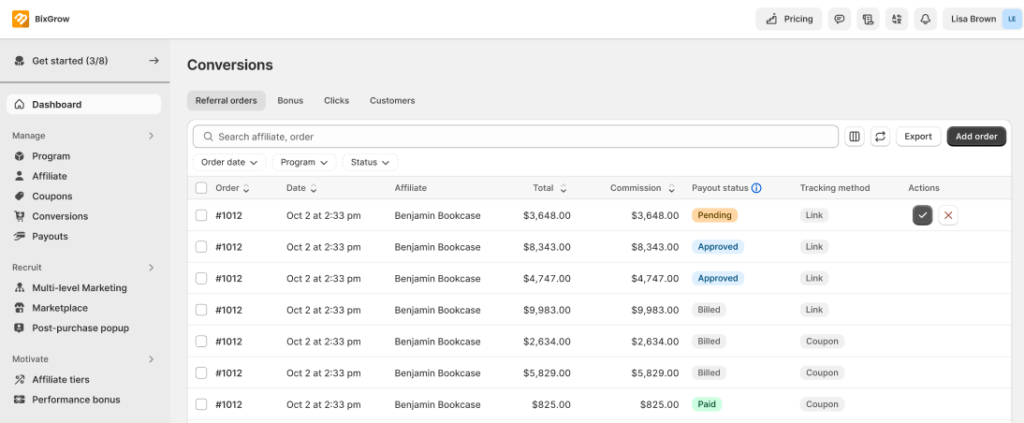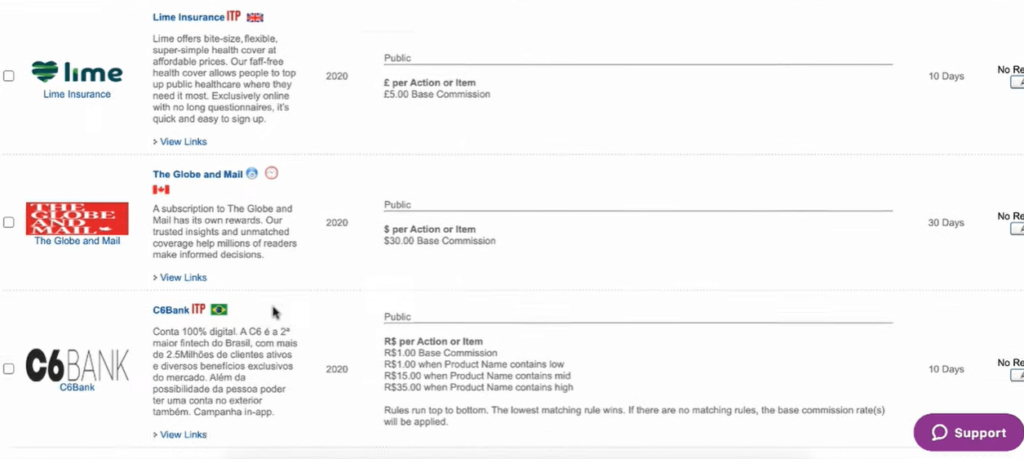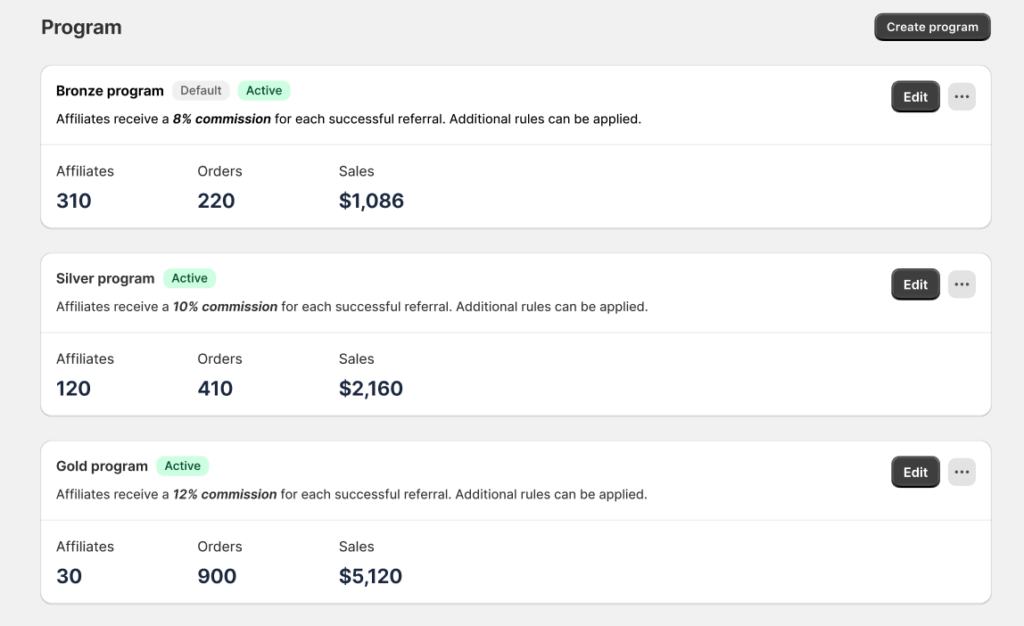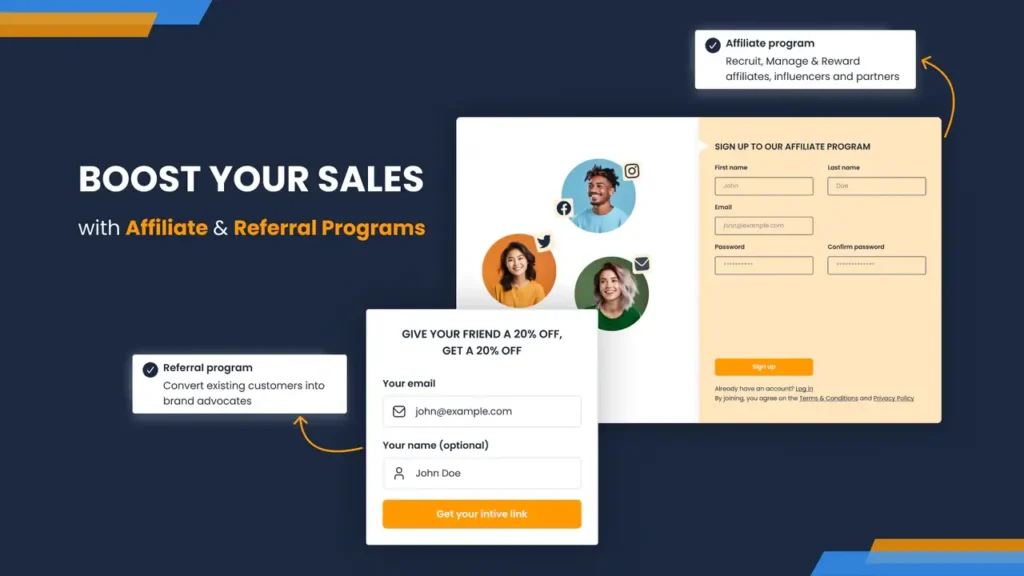If you are here, you probably have thought of how to manage affiliates effectively!
Well, though affiliate management is more likely person-person communications, it is not entirely so. There is a technical side that helps you to identify situations and hardships of affiliates.
And here are 15+ actionable tips to help you streamline your affiliate management process, a mutually beneficial partnership. Stay tuned for detailed strategies that will transform your affiliate program into a success story
What is Affiliate Management?
More and more people fall in love with affiliate marketing and are thinking of becoming an affiliate. People’s interest rose 264% between 2020 and 2024, and it seems to be growing.
Affiliate management focuses on building relationships between the business and its affiliates. It involves nurturing and maintaining positive relationships with affiliates, supporting them, communicating effectively, and ensuring they have the tools and motivation to succeed in promoting the products or services.
Affiliate management is the subset and the most important part of managing an affiliate program. Though affiliate program management includes various aspects of running an affiliate program, affiliate management is more focused on affiliates and how to help them achieve their best.
What is involved in affiliate management?
Affiliate management involves various tasks and responsibilities aimed at following and optimizing an affiliate program. It includes 02 parts: affiliate-advertiser direct communication and technical tracking.
Here are some key components involved in affiliate management:

Stage 1: Setting goals for the affiliate program
Most goals of the program can be measured through affiliate performance. In other words, the achievement of the goal highly depends on the quality of affiliate performance.
See more: How to Build an Affiliate Program (8 Steps)
Stage 2: Outreach & Recruitment
Initial outreach is the starting stage of affiliate marketing.
Affiliate managers identify and reach out to individuals/ organizations with relevant audiences or niches related to their products. Then, this outreach can be conducted via email or through an affiliate management platform.
Once affiliates show interest in joining the program, the onboarding process begins.
Stage 3: Affiliate Guidance
Provide a comprehensive welcome package or orientation material to new affiliates, including business basic information, commission structure, basic rules of the program…
Offering training sessions or webinars is sometimes an option.
Stage 4: Performance Tracking
This stage does not involve direct communication with affiliates, but it is crucial to evaluate how good the affiliates’ work is and the effectiveness of the affiliate program.
Affiliates use tracking links provided by the platform, and performance metrics are monitored in real time. Businesses have access to report dashboards (from management platforms) to monitor affiliate performance and campaign effectiveness.

Stage 5: Communication
Communication is the most important part of affiliate management.
The main purpose of this step is to keep affiliates engaged and well-informed about news.
It may include brand promotions, product launches, and performance.
Stage 6: Building relationships
Building relationships is conducted during communication and although they are overlapping, they are not the same.
Relationship building includes rapport, trust, and mutual understanding.
A strong relationship leads to affiliates’ better understanding of your business. The stronger the relationship is, the more time and effort into promoting your product. It results in a win-win scenario where both parties benefit from the partnership.
Stage 7: Incentivization
Businesses offer incentives to motivate affiliates and reward performance.
Incentives may include commission bonuses, tiered commission structures, or exclusive rewards for top-performing affiliates. The affiliate management platform allows affiliate managers to pay accurately and promptly.
Stage 8: Program optimization
You can identify trends and track goals by analyzing data. Therefore, there will be areas to improve.
In many cases, program managers have to experiment with different commission structures, affiliate groups, and creative assets to determine what drives the highest ROI. But be careful, it is very easy to mistake what really caused the result, the affiliate or the brand.
The Role of an Affiliate Manager
The role of an affiliate manager is pivotal. Their main task is to design and oversee the affiliate program and communicate with affiliates.
An affiliate manager takes charge of setting affiliate entry standards, recruiting new affiliates, negotiating partnerships, tracking and analyzing performance metrics, resolving disputes, and continuously optimizing the program.
They are also the primary point of contact for affiliates, providing support, guidance, and motivation to ensure their success.
Overall, an affiliate manager’s communication skills, interpersonal abilities, and strategic thinking are instrumental in driving the success of the affiliate program.
Tools to manage affiliates
People used to manage affiliates manually, but as the affiliate marketing industry has become bigger and more complex, manual actions do not help. Now, people use automation.
You can manage affiliates through 02 types of platforms. These platforms typically include affiliate software and affiliate networks.
Affiliate Software
Affiliate software platforms are designed to help businesses set up, manage, and track their affiliate programs efficiently.
Examples of popular affiliate software platforms include:
- BixGrow
- AffiliateWP
- HasOffers by TUNE
Advantages of this software:
- High level of customization, allowing businesses to tailor their affiliate program to their specific needs. Plus, they have full control over their affiliate program.
- Some affiliate software options offer scalable pricing plans, making them a cost-effective solution for businesses of all sizes.
- Businesses can communicate directly with their affiliates through built-in messaging systems.
The drawbacks:
- Setting up affiliate software can require technical expertise and time investment, especially for businesses with complex program requirements.
- Affiliate software platforms do not provide access to a network of affiliates, requiring businesses to recruit affiliates independently.
Affiliate Networks
Affiliate networks act as intermediaries between businesses (merchants) and affiliates.

They provide a platform where merchants can list their affiliate programs, and affiliates can browse and join multiple programs within the network. Affiliate networks handle tasks such as affiliate recruitment, tracking, and payments, and sometimes even offer additional support services.
Examples of well-known affiliate networks include:
- CJ Affiliate (formerly Commission Junction)
- Rakuten Advertising (formerly Rakuten Marketing)
- ShareASale
The biggest advantages of this platform businesses:
- Access to a large pool of affiliates, making it easier to recruit partners
- It simplifies program management for businesses with built-in tracking, reporting, and payment tools.
Drawbacks of affiliate networks:
- Businesses don’t have full control over their affiliate program. There are a bunch of network policies that they must adhere to.
- Requirements of joining include upfront costs
- Ongoing fees such as network membership fees and a cut of commission payouts. In other words, the more affiliates you have, the more money you have to pay for the network.
Using either affiliate software or joining affiliate networks can streamline the management of your affiliate program. They are providing various tools and resources to effectively recruit, manage, and track affiliates, as well as facilitating payments and reporting. There are many options out there that fit your demands and budgets.
15+ tips for managing affiliates effectively
Managing affiliates effectively is crucial for the success of your affiliate marketing program. Here are 10 actionable tips to help you maintain strong relationships with your affiliates and optimize your program:
Setting a groundwork
Tip 01: Setting reasonable goals
When overseeing an affiliate program, it’s crucial to set clear and achievable goals.
Make sure these goals are specific and measurable, like boosting sales or reaching new markets. Tell your affiliates what you expect from them and support them along the way.
Your goal can be measured by some key metrics including CLV, ROI, and Commission Rate.
Tip 02: Categorize affiliates before launching an affiliate program
Grouping affiliates into categories can significantly enhance the management process of your affiliate program, ensuring clearer insights and better-organized communication.
By categorizing affiliates into groups, you can tailor your approach to each group’s specific needs and preferences, consequently leading to more effective communication, better resource allocation, and enhanced overall program effectiveness.
Each different group of affiliates may enjoy different commission rates, and access to varying products, and promotional materials. Having that many modifiers in one affiliate program may be complicated.
With the aid of tools like BixGrow, you can operate multiple affiliate programs at the same time and efficiently manage affiliates and track their performance of each group within the affiliate network.

Tip 03: Choose a suitable affiliate management system
Affiliate marketing can bring significant growth in brand reach, entailing a large amount of data and workload to process.
At some point, it is a huge burden.
Thankfully, automation helps with this. Tools like affiliate marketing software meet the needs of running a successful affiliate program.
They track affiliate sales and other important data in real-time, and automatically pay commissions on time. They also provide a user-friendly dashboard where they can see their performance instantly and access various marketing resources.
But why choose link management software over an affiliate network? Well, affiliate networks have certain limitations:
- They control and (though rarely) interfere with your association data and relationships.
- Plus, they take a share of the affiliate commission. This means maintenance costs will vary based on your revenue. The more effective the affiliate, the higher the maintenance fee.
- The customizations for the affiliate program are extremely limited.
Managing affiliates with software gives full autonomy, helping you save money.
BixGrow is the top marketing Shopify app (in case you wanna give it a try).
Recruiting and onboarding affiliates
Tip 04: Quality over Quantity
These tips can be explained in a simple sentence: “80% of your sales are made by 20% of affiliates”
Real-life examples? Just check the case of Ahref. Most affiliates sent them few or no leads. As their top 3% of bring 90% of the sales.
You do not need to be extreme like Ahrefs, but, indeed, quantity is not always power.
Quality means your affiliate genuinely drives relevant traffic and sales to your business.
For example, if you’re selling eco-friendly products, it’s more beneficial to collaborate with influencers or bloggers who have a dedicated following interested in sustainability, and not necessarily one with the largest following.
Plus, a large quantity means you need a big team to manage affiliates effectively. Considering your human resources carefully, or else you can not keep track of your affiliate properly.
Tip 05: Provide promotional materials with uniformity
A big mistake brands make is letting affiliates design whatever they want to promote the product.
This leads to inconsistent product images in the eyes of consumers.
Ideally, the branch should issue a uniform theme for all affiliates, a theme set that represents the brand. It may include banners, product descriptions, and social media content.
For example, you can create many different templates for your brand, but it’s best to keep the main colors and brand slogan.
This tip does not directly affect the relationship between brands and affiliates, however, it makes the product promotion material easier to use and manage affiliates easy like never before.
Communication and Informing
To make sure communication is happening seamlessly and affiliates are updated.
Tip 06: Keep affiliate updated monthly
Maintain open lines of communication every month. Besides reporting the affiliate’s performance in the past month, this also helps the affiliate update new promotional programs or product launches.
This, moreover, keeps affiliates engaged. Address any questions, concerns, or feedback promptly.
Don’t forget to show appreciation for their efforts and celebrate their successes. Any highly personalized content is effective in strengthening the relationship between both parties.

Tip 07: Focus on one communication channel
Current platforms allow too many communication ports. People can connect through email, affiliate networks, and even social networks like LinkedIn or Facebook.
Such communication is very easy for affiliates, as they can proactively reach out through any channel that is convenient for them.
However, for an affiliate manager, multi-channel communication is a nightmare.
Imagine, you are the program manager, managing 200 affiliates at once, and have to check the chat history of 3 communication channels at the same time, to find a document from 6 months ago. Terrible.
So, let’s focus on one main communication channel, the most popular and easiest of which is email. And make sure the affiliate is educated about this during the onboarding process.

See more: 15 affiliate marketing email templates (that brands need)
Don’t forget to add a backup communication channel – professionalism is a priority – such as an affiliate manager’s personal LinkedIn.
Relationship-building
Tip 8: Ask for affiliates’ reviews of the affiliate program
In many cases, the affiliate program has shortcomings and the affiliate – the person who is constantly exposed to the program’s policies – sees it most clearly.
And, in many cases, affiliates do not speak up about this. They want to avoid unnecessary disputes that can damage the relationship with the advertiser. It’s also possible that they consider it a minor inconvenience and decide to ignore it.
So proactively ask your affiliate for their opinion. In marketing, a small change can change the entire performance and output.

Tip 9: Make a sense of community
Affiliates are a powerful resource for spreading your story. They are extremely, if not pivotal, important in communication campaigns.
Activities that nurture a sense of community can be contests, forums, or webinars and workshops for affiliates.
Digital and physical interactions both work. So, there are multiple and flexible choices for hosting such events.
The biggest inspirations come from successful individuals in the network, or individuals with creative ways of communicating.
Tips for affiliate performance tracking
Tip 10: Data Filters for Affiliate Performance Tracking
Remember to note affiliate segmentation in the first part. This is when they come into play.
Segment your affiliates based on performance metrics or based on affiliate category.
Key metrics to consider include sales volume, conversion rate, and engagement.
Through this, you will identify the strongest points in your affiliate system, as well as the problem areas. Identifying well-performing affiliates and problems.
Evaluate key performance indicators (KPIs) like click-through rate, conversion rate, average order value, and return on investment (ROI) to evaluate affiliate performance.
Incentivization
Tip 11: Offer a Strategic Commission Structure
Motivate affiliates by offering competitive commissions. Consider performance-based tiers or bonuses to incentivize higher sales.
Offer commission rates that are attractive to affiliates and reward top performers with bonuses or incentives.
Take the Audible Affiliate Program for example. Here is their commission structure:

Approximately 1 in 10 users signed up for a free trial upgrade to the gold membership.
A free trial sign-up yields a fixed $5 commission. They make $50 for 10 successful trials. and another $10 for a customer upgrading their subscription. The affiliate earns a total of $60.
So, you can realize that promoting Audible free-trial is more lucrative for affiliates. On the audience side, they lose nothing to start a free trial.
Clearly, this commission structure shows that Audible focuses on improving its brand reach.
(In fact, most affiliates report that a significant portion of their earnings comes from promoting “free trials”, rather than “audiobooks“ and “gold digital membership”. )
The drawback? Many Audible affiliates focus simply on lead generation (i.e. trying to get people to sign up for the trial) rather than nurturing customers (which may lead to sustainable income from customer’s regular book purchases).
Tip 12: Offer Exclusive deals
Exclusive deals are a motivator to boost sales and boost their motivation.
They may include special discounts, presales products, promotions, or packages available only through your affiliate channels, giving affiliates a unique selling point to attract customers.
Exclusive offers create a sense of urgency and exclusivity for consumers, encouraging them to purchase through affiliate links to access the special offer.
This not only increases conversion rates but also strengthens the relationship between affiliates and their audiences.
Tip 13: Show testimonials
Sharing stories from happy affiliates can indeed create a positive image of your program in the eyes of affiliates.
These stories show how affiliates have succeeded, earning more money and feeling supported by the program. When potential affiliates, or simply a passerby see these stories, they’re more likely to trust that your program can help them too.
Make sure to collect and update these stories regularly, and feature them prominently on your website and in your promotional materials. By sharing affiliate stories, you’ll attract more affiliates and build a stronger sense of trust in your program.
Here is an example from Temu:

Program Optimization
Tip 14: Regular program reviews
Regular affiliate performance tracking will help you get an objective assessment of the program. Thanks to that, you can adjust it as needed to optimize performance.
The program’s performance is continually in line with your original goals. Analyze metrics like conversion rates, click-through rates, and revenue.
You can perform a/b testing with products, promotional resources, or commission structures.
Tip 15: Offer Support to Struggling Affiliates
Identifying struggling affiliates is critical to optimizing your affiliate program’s performance.
Look for affiliates that may have low revenue or engagement compared to other affiliates in the program.
Biggest problem? Difficult affiliates don’t appear right before your eyes. The data may show you low-performing affiliates, but it doesn’t differentiate whether they come from an inactive affiliate or an affiliate having difficulty promoting.
Identifying a struggling affiliate requires industry knowledge, as well as the ability to seek insights from an affiliate manager.
Once you’ve identified affiliates that are struggling, reach out to them for personalized support and guidance. Suggest new marketing tactics or provide additional resources and training materials, in short, everything is within reach.
Human resources are precious, and you don’t want to miss out on an affiliate who is truly serious about his work.
By actively supporting struggling affiliates, you not only help them succeed but also strengthen the overall effectiveness of your affiliate program. A win-win situation.
Tip 16: Remove inactive affiliates
As mentioned, there are inactive affiliates.
These people are people who have not generated any revenue or activity in the specified period.
However, the problems you can’t comprehensively identify the just via data from affiliate programs or surface signs. You may mistakenly delete active but low-performing affiliates.
So, the tip is to actually contact them, learn about their status, and offer support or encouragement to re-engage them.
If your efforts to restore their participation are unsuccessful, consider removing them from your affiliate program. Removing affiliates, optimally, is to have consent from both parties.
Removing inactive affiliates helps maintain a lean and cohesive affiliate network, ensuring that resources and attention are focused on affiliates that actively contribute to the program.
Start affiliate management with the top software
Unlike traditional affiliate networks, the software offers greater control, customization, and real-time analytics, allowing you to optimize the program.
BixGrow is a Shopify app that specializes in management, delivering results for our clients. It helps merchants and program managers manage affiliates seamlessly.
Contact us today to elevate your program to new heights!

Keep your program outperformed. Reach out to us and unlock its full potential today!
Unlike traditional affiliate networks, the software offers greater control, customization, and real-time analytics, allowing you to optimize the program.